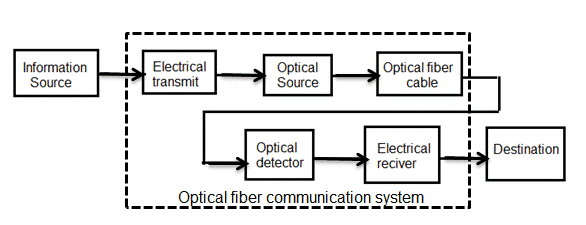Optical Fiber | Optical Fiber Communication | Working Principle | Types and Applications
Optical Fiber
The optical fiber is a device which works on the principle of total internal reflection by which light signal can be transmitted from one place to another with a negligible loss of energy. A optical fiber is a very fine glass rod of 125 µm. After manufacturer it has a central glass core surrounded by a glass coating or cladding of smaller refractive index than the core.
Construction
It consists of a very thin fiber of silica or glass or plastic of a high refractive index called the core. The core has a diameter of 10µm-200µm. The core is enclosed by a cover of glass or plastic called cladding. The refractive index of the cladding is a less than that of the core which is a must conditions for the working of the optical fiber. The fiber is coated during the drawing process with polyethylene or epoxy for protection, and in some instances color coding is applied, according to the users' needs. All data concerning the fiber is then measured (bandwidth, refractive index, cladding thickness, timed reflectometer response, and so on) and recorded. The basic single-fiber cable consists of the following :
- Core- quartz
- Cladding- silica
- Jacket- acrylic
- Buffer Jacket
- Strength member
- Outer Jacket
Working Principle
The fiber optic works on the principle of total internal reflection. When a Ray of light is incident on the core of the optical fiber at a small angle, it suffers refraction and strikes the core cladding interface. As the diameter of the fiber is very small hence the angle of incidence is greater than the critical angle. Therefore, the ray suffers total internal reflection at the core cladding interface and strikes the opposite interface. At this interface also the angle of incidence is greater than the critical angle, so it again suffers total internal reflection. Thus, the Ray of light reaches the other end of the fiber after suffering repeated total internal reflection along the length of the fiber. At the other end, the ray suffers refraction and emerge out the optical fiber without loosing energy.
n2 < n1
Types of Optical fiber
Depending upon the material composition of the core, there are two types of fibers used commonly. They are-
1. Step index
The refractive index of the core is uniform throughout and undergoes an abrupt change at the cladding boundary.
2. Graded index
The core refractive index is made to vary as a function of the radial distance from the center of the fiber. Both of these are further divided into-
- Multimode step-index fiber
- Multimode graded-index fiber
- Single-mode step-index
Multimode step-index fiber
The multimode step-index fiber has a core diameter of from 100 to 970 micrometer. With this large core diameter, there are many paths through which light can travel. Therefore, the light ray travelling the straight path through the center reaches the end before the other rays, which follows a zigzag path. The difference in the length of time it takes the various light rays to exist the fiber is called modal dispersion. This is form of a single distortion with limit the bandwidth of the fiber.
Multimode graded-index fiber
The multimode graded-index fiber is an improvement of the multimode step-index fiber. Because light rays travel faster through the lower index of refraction, the light at the fiber core travels more slowly than the light nearer the surface. Therefore, both light rays arrive at the exit point at almost the same time, reducing modal dispersion. A typical graded-index fiber has core diameters ranging from 50 to 85 µm and a cladding diameter of 125 µm.
Single-mode step-index fiber
Single-mode step-index fibers are the most widely used in today is wideband communications arena. With this fiber a light ray can Travel on only one path; therefore modal dispersion is zero. The core diameter of this fiber range from 5 micrometer to 10 micrometer. The extra cladding thickness tends to set an overall fiber size standard and make the fiber fragile.
Optical Fiber Communication
The communication system of fiber optics is well understood by studying the parts of section of it. The major elements of an optical fiber communication system are someone in the following figure.
The basic components are light signal, transmitter, the optical fiber and photo detecting receiver. The additional element such as fiber and cable is splicers and connectors, regenerators, beam splitters and optical amplifier are employed to improve the performance of the communication system.
Advantages of Optical Fiber
- Transmission bandwidth of the fibre optic cables is higher than the metal cables.
- The amount of data transmission is higher in fibre optic cables.
- The power loss is very low and hence helpful in long distance transmissions.
- Fiber optic cables are the most source way for data transmission and these are not affected by electrical noise.
- Since these cables are dielectric, no Spark hazards are present.
- These cables are more corrosion resistance than copper cables, as they are bent easily and flexible.
Disadvantages of Optical fiber
Although fiber optics offer many advantages, they have the following disadvantages-
- Though fibre optic cables last longer, the installation cost is high.
- They are Fragile if not in enclosed in plastic sheath. Hence more protection is needed than copper ones.
- The number of repeaters are to be increased by the distance.
Application of Fiber Optics
- Used in telephone system.
- Used in submarine cable network.
- Used in CCTV surveillance cameras.
- Used in hospitals, schools, and traffic management system.




